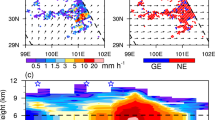Summary
First intensive observations of a narrow cold frontal rainband in southern Germany are described. The observations by Doppler radar and surface observations are in good agreement with others made in Great Britain and at the west coast of the United States. There are no principal differences between the observations close to the sea and those during the passage of the front across the Alpine foreland. The observed coexistence of short and elongated precipitation cells is explained by the local modification of convergence and vorticity. When approaching the Alps the precipitation patterns increased in size due to the upslope winds, and the pre-frontal low-level jet is reorganized completely in a manner such that the cross-frontal circulation was enhanced while the pre-frontal low-level jet disappeared.
Similar content being viewed by others
References
Battan, L. J., 1973:Radar Observation of the Atmosphere. Chicago: The University of Chicago Press, 324 pp.
Bringi, V. N., Rasmussen, R. M., Vivekanandan, J., 1986: Multiparameter radar measurements in Colorado convective storms. Part I: Graupel melting studies.J. Atmos. Sci.,43, 2545–2563.
Browning, K. A., 1985: Conceptual models of precipitation systems.Meteorol. Magazine,114, 293–319.
Browning, K. A., Harrold, T. W., 1970: Air motion and precipitation growth at a cold front.Quart. J. Roy. Meteor. Soc.,96, 369–389.
Browning, K. A., Pardoe, C. W., 1973: Structure of low-level jet streams ahead of mid-latitude cold fronts.Quart. J. Roy. Meteor. Soc.,99, 619–638.
Browning, K. A., Pardoe, C. W., Hill, F. F., 1975: The nature of orographic rain at wintertime cold fronts.Quart. J. Roy. Meteor. Soc.,101, 333–352.
Browning, K. A., Wexler, R., 1968: The determination of kinematic properties of a wind field using Doppler radar.J. Appl. Meteor.,7, 105–113.
Carbone, R. E., 1982: A severe frontal rainband. Part I: Stormwide hydrodynamic structure.J. Atmos. Sci.,39, 258–279.
Davies, H. C., 1984: On the orographic retardation of a cold front.Beitr. Phys. Atmos.,57, 409–418.
Emanuel, K. A., 1990: Notes on the physical mechanisms of mesoscale precipitation bands. In: Atlas, D. (ed.)Battan Memorial Volume on Radar Meteorology, Boston: Amer. Meteor. Soc., pp. 473–476.
Hagen, M., 1992: Estimation of the horizontal wind vector from a single Doppler radar with application to a cold front.J. Atmos. Ocean. Tech. (submitted).
Heimann, D., 1990: Three-dimensional modeling of synthetic cold fronts approaching the Alps.Meteorol. Atmos. Phys.,42, 197–219.
Heymsfield, A. J., 1977: Precipitation development in stratiform ice clouds: A microphysical and dynamic study.J. Atmos. Sci.,34, 367–381.
Hobbs, P. V., 1978: Organization and structure of clouds and precipitation on the mesoscale and microscale in cyclonic storms.Rev. Geophys. Space Phys.,16, 741–755.
Hobbs, P. V., Biswas, K. R., 1979: The cellular structure of narrow cold-frontal rainbands.Quart. J. Roy. Meteor. Soc.,105, 723–727.
Hobbs, P. V., Houze, R. A. Jr., Matejka, T. J., 1975: The dynamic and microphysical structure of an occluded frontal system and its modification by orography.J. Atmos. Sci.,32, 1542–1562.
Hobbs, P. V., Persson, P. O. G., 1982: The mesoscale and microscale structure and organization of clouds and precipitation in midlatitude cyclones. V: The substructure of narrow cold-frontal rainbands.J. Atmos. Sci.,39, 280–295.
Hoinka, K. P., 1985: On fronts in Central Europe.Beitr. Phys. Atmos.,58, 560–571.
Hoinka, K. P., Hagen, M., Volkert, H., Heimann, D. 1990: On the influence of the Alps on a cold front.Tellus,42A, 140–164.
Hoinka, K. P., Volkert, H., 1992: Fronts and the Alps: Findings from the Fronts Experiment 1987.Meteorol. Atmos. Phys.,48, 51–75.
James, P. K., Browning, K. A., 1979: Mesoscale structure of line convection at surface cold fronts.Quart. J. Roy. Meteor. Soc.,105, 371–382.
Joss, J., Waldvogel, A., 1970:Raindrop Size Distribution and Doppler Velocities, Proc. 14th Radar Meteor. Conf. Tuscon, Boston: Amer. Meteor. Soc., pp. 153–156.
Marwitz, J. D., 1989:Cold Frontal Passage over the Sierra Barrier. Proc. 24th Radar Meteor. Conf. Tallahassee, Boston: Amer. Meteor. Soc., pp. 475–477.
Moore, G. W. K., 1985: The organization of convection in narrow cold-frontal rainbands.J. Atmos. Sci.,42, 1777–1791.
Parsons, D. B., 1992: An explanation for intense frontal updrafts and narrow cold-frontal rainbands.J. Atmos. Sci. (in press).
Parsons, D. B., Hobbs, P. V., 1983a: The mesoscale and microscale structure and organization of clouds and precipitation in midlatitude cyclones. VII: Formation, development, interaction and dissipation of rainbands.J. Atmos. Sci.,40, 559–579.
Parsons, D. B., Hobbs, P. V., 1983b: The mesoscale and microscale structure and organization of clouds and precipitation in midlatitude cyclones. IX: Some effects of orography on rainbands.J. Atmos. Sci.,40, 1930–1949.
Parsons, D. B., Hobbs, P. V., 1983c: The mesoscale and microscale structure and organization of clouds and precipitation in midlatitude cyclones. XI: Comparisons between observational and theoretical aspects of rainbands.J. Atmos. Sci.,40, 2377–2397.
Parsons, D. B., Mohr, C. G., Gal-Chen, T., 1987: A severe frontal rainband. Part III: Derived thermodynamic structure.J. Atmos. Sci.,44, 1615–1631.
Schroth, A. C., Chandra, M. S., Meischner, P. F., 1988: A C-band coherent polarimetric radar for propagation and cloud physics research.J. Atmos. Oceanic Technol.,5, 803–822.
Schumann, U., 1987: Influence of mesoscale orography on idealized cold fronts.J. Atmos. Sci.,44, 3423–3441.
Seliga, T. A., Bringi, V. N., 1976: Potential use of radar differential reflectivity measurements at orthogonal polarization for measuring precipitation.J. Appl. Meteor.,15, 69–76.
Wilson, J., Carbone, R., Ramsay, B., 1981:Precipitation and Precipitation Efficiencies Derived from Single Doppler Radar. Proc. 20th Radar Meteor. Conf. Boston, Boston: Amer. Meteor. Soc., pp. 461–468.
Author information
Authors and Affiliations
Additional information
With 20 Figures
Rights and permissions
About this article
Cite this article
Hagen, M. On the appearance of a cold front with a narrow rainband in the vicinity of the Alps. Meteorl. Atmos. Phys. 48, 231–248 (1992). https://doi.org/10.1007/BF01029571
Received:
Revised:
Issue Date:
DOI: https://doi.org/10.1007/BF01029571




